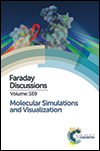Udock, the interactive docking entertainment system
Abstract
Protein–protein interactions play a crucial role in biological processes. Protein docking calculations' goal is to predict, given two proteins of known structures, the associate conformation of the corresponding complex. Here, we present a new interactive protein docking system, Udock, that makes use of users' cognitive capabilities added up. In Udock, the users tackle simplified representations of protein structures and explore protein–protein interfaces’ conformational space using a gamified interactive docking system with on the fly scoring. We assumed that if given appropriate tools, a naïve user's cognitive capabilities could provide relevant data for (1) the prediction of correct interfaces in binary protein complexes and (2) the identification of the experimental partner in interaction among a set of decoys. To explore this approach experimentally, we conducted a preliminary two week long playtest where the registered users could perform a cross-docking on a dataset comprising 4 binary protein complexes. The users explored almost all the surface of the proteins that were available in the dataset but favored certain regions that seemed more attractive as potential docking spots. These favored regions were located inside or nearby the experimental binding interface for 5 out of the 8 proteins in the dataset. For most of them, the best scores were obtained with the experimental partner. The alpha version of Udock is freely accessible at http://udock.fr.
- This article is part of the themed collection: Molecular Simulations and Visualization

 Please wait while we load your content...
Please wait while we load your content...